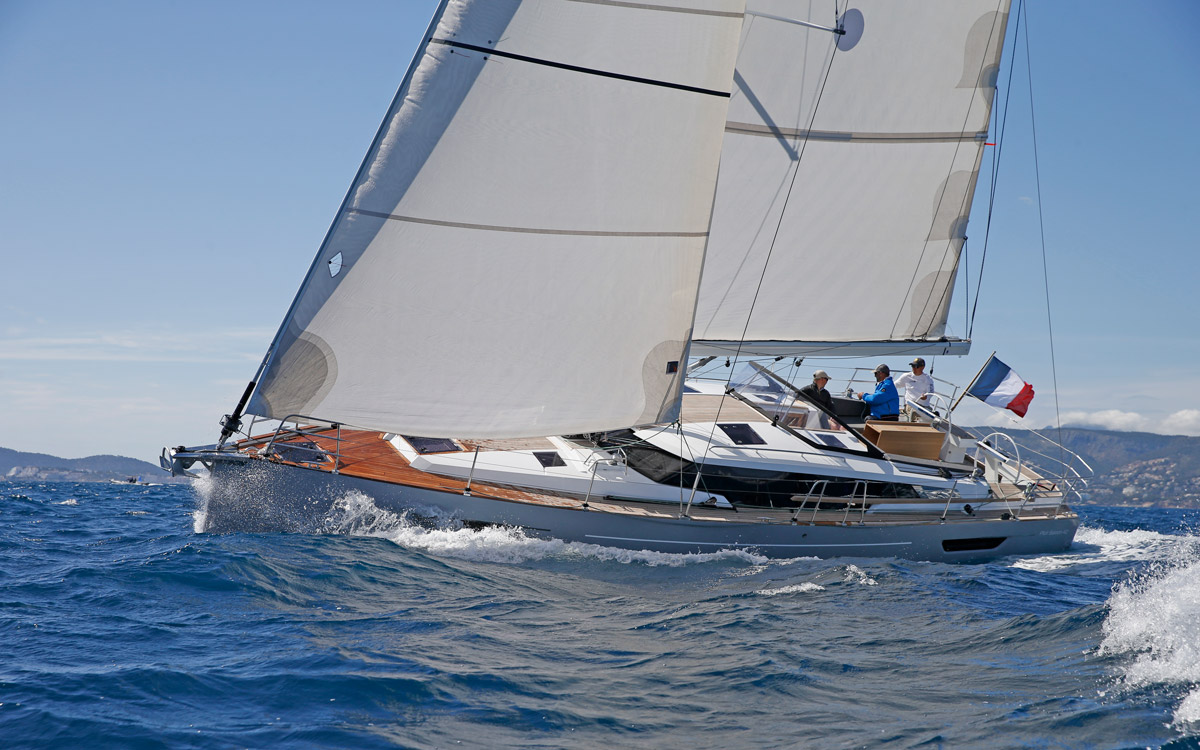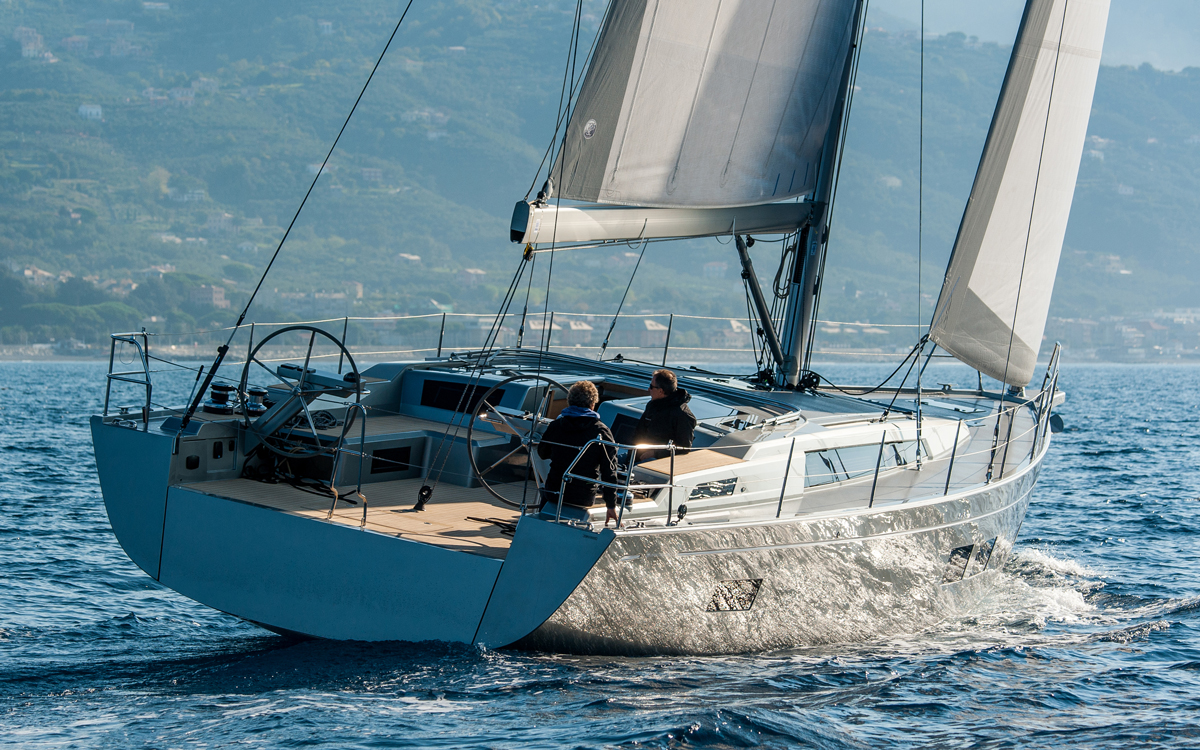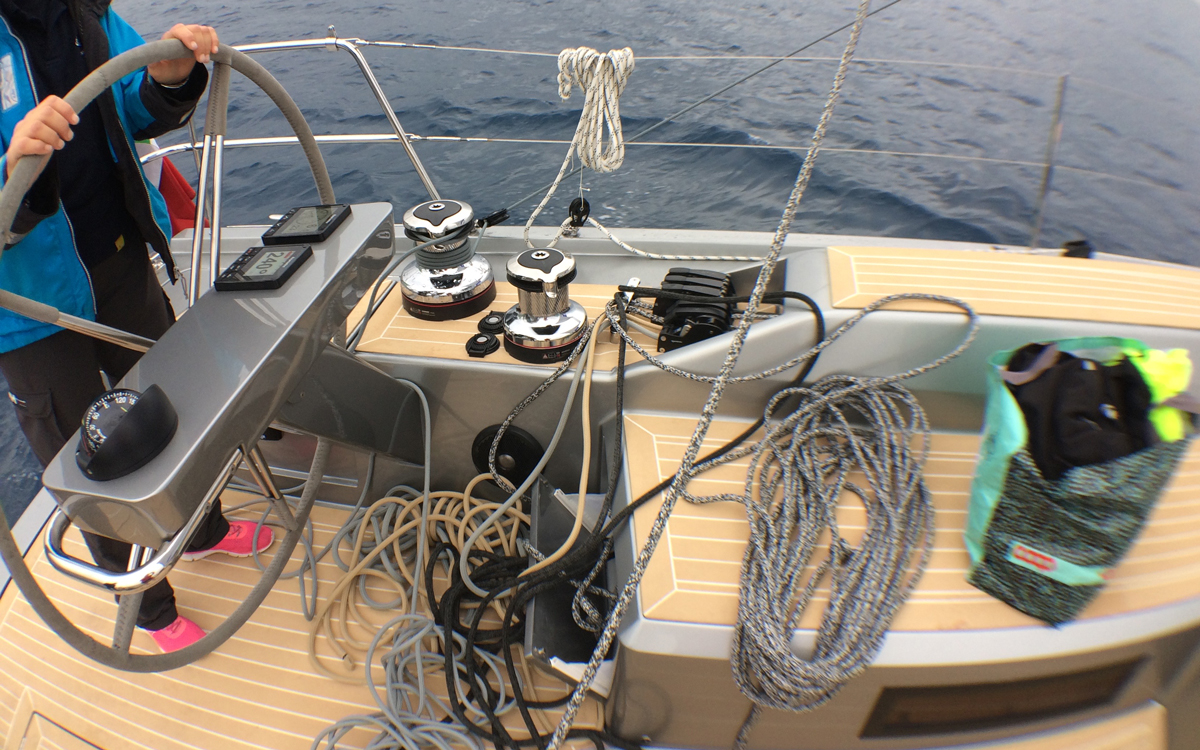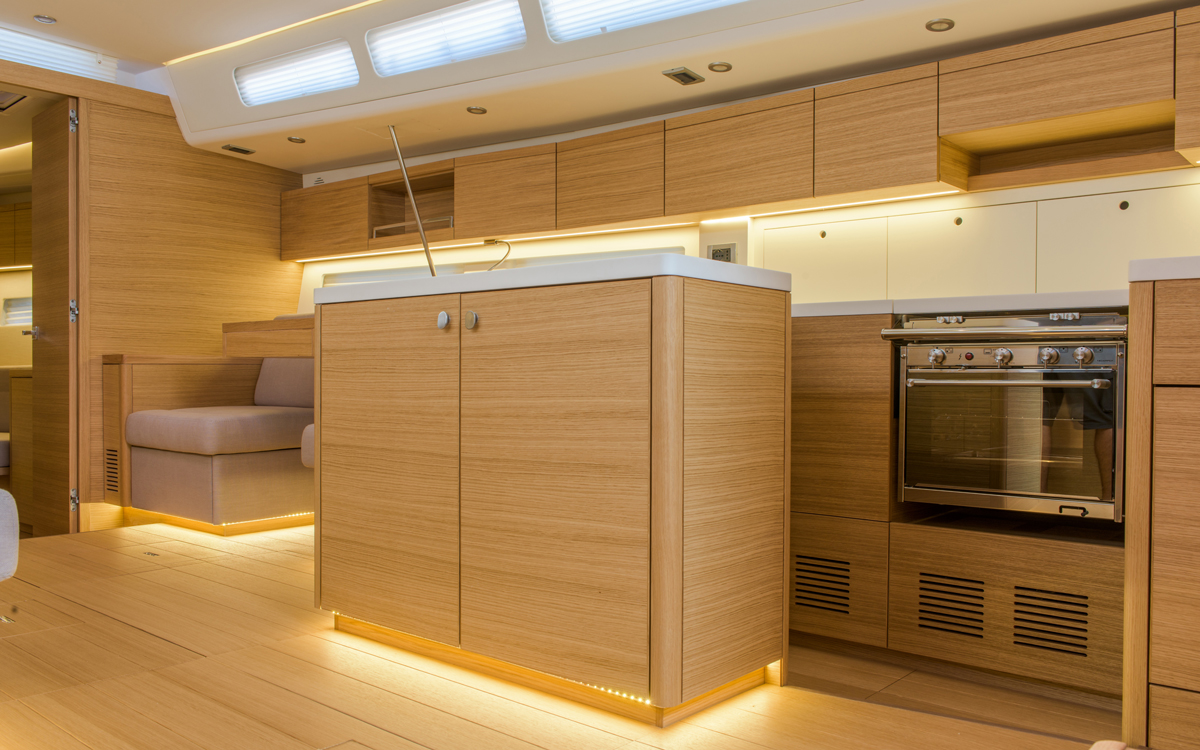The sport version of the 52LC draws on Grand Soleil’s performance heritage. Pip Hare sailed it in Lavagna
The Grand Soleil 52 Long Cruise Sport (52LC) is wedged, stern-to, in between a grubby ketch and a motorboat. Its long decks are finished in graphite gelcoat, which absorbs the light, allowing no reflections, while black hatches and windows prevent a direct view inside. The deck is empty, with the mechanics of sailing hidden from view in the vast cockpit. This boat seems mismatched with its unglamorous surroundings… almost like a computer-generated artist’s impression.
Despite the futuristic first impressions of the test boat, the lines of the 52LC fly in the face of current cruising boat fashion – there’s not a chine to be seen. The bow is blunt but slim, topped off with a chunky carbon bowsprit and anchor roller.
The full beam of nearly 5m (16ft) is achieved at roughly half the waterline length and carried all the way aft on deck. The waterline gently nips in at the stern allowing the topsides to flare slightly in the aft end, creating curves on the transom. The overall look is understated, maybe a bit old school, but like a well-cut suit it oozes style.
In 2015, after producing more than 4,000 performance yachts over four decades, Grand Soleil made a bold decision to launch its first cruising yacht. The 52LC follows on from that popular 46LC debut model, and is once again the result of an Italian design collaboration between Marco Lostuzzi for the hull lines and Nauta Yachts for the interior.
The Long Cruise range sits at the opposite end of the spectrum to Grand Soleil’s usual performance yachts. It offers a ‘low impact’ sailing experience, with the focus on lifestyle to attract customers who might not want such an energetic experience on the water. There’s even an option to convert the forward sail locker to separate crew quarters.
However, in what appears to be a step back towards the middle ground, Grand Soleil has now developed an uprated performance package for the Long Cruise range, so the 52LC is available in ‘Sport’ guise too. It was this 52LC Sport that we put through its paces amid the impressive backdrop of the Cinque Terre in Italy. The Sport package comprises a higher mast (sail area increased by 14m2), a mainsheet tacked down to a central point on the cockpit floor (hence no roll bar), rod rigging, a hydraulically adjustable backstay and larger winches.

Loose-luffed offwind sails help gain the best performance. For those with reduced crew, however, a furling Code 0 may be more practical
The package is a compromise for those who still hanker after traditional Grand Soleil performance, but maybe whose friends and family don’t feel the same. For most sailors, a performance 52-footer is going to be a handful that requires a number of crew to keep control. The 52LC Sport promises a taste of that performance, yet can be handled by minimal crew.
I was keen to see how the boat felt, if it really could be sailed by one or two crew, and whether there was still a Grand Soleil stallion champing at the bit under the new, calmer, exterior.
On the water
We left Lavagna, hoisted the asymmetric spinnaker and quickly the coast disappeared behind us as we easily pushed our boat speed to 9 knots in a wind speed of only 11 true. We were a crew of three for the test sail and during the hoist and drop of our unfettered spinnaker the third person was definitely appreciated; for a crew of two, offwind sails with snuffers or furlers would be more appropriate for a boat this size.
I pressed to higher angles testing for excessive loads on the rudder but, even at 110° to the true wind, there were no ill effects. Everything was smooth and under control as the full length of the 52LC cut through the flat water. In the light test winds, we struggled to keep the spinnaker full at wind angles lower than 135° true – we had to revert to white sails for sailing dead downwind.
In 9 knots of wind and very flat water the mainsail alone was able to push our 17 tonnes displacement along at a solid 4 knots. Considering the Sport package has extra sail area, I was left wondering how effective the standard size main would be in lighter winds.
Both the standard 52LC and Sport versions are offered with in-mast furling as standard. The test boat had membrane sails with full vertical battens in the main.
The Sport package uses a German mainsheet system tacked to a single point in the cockpit, led forward under the boom then back to jammers in front of each helm. This allows sheeting from the end of the boom, giving greater leech tension and bringing the boom closer to the centreline in comparison to the standard rollbar equivalent.
A hydraulic backstay pump on the Sport version will help to flatten the mainsail and reduce forestay sag. There is no traveller, so off the breeze the kicker is needed to reduce twist. Owners opting for the Sport package’s greater mainsail control would undoubtedly need to invest in a high-quality main to reap the benefits offered by this extra ‘trimability’.
The 52LC comes with a self-tacking jib as standard, but the test boat had longitudinal tracks on the coachroof as well. These inboard sheeting positions gave us great sail shape upwind in flat water, but I’d question their efficacy in other conditions.
When sailing off the breeze it might be difficult to prevent the top of the jib from twisting open, as the tracks are relatively far inboard. The jib cars are not adjustable from the cockpit but instead set with pins – which to me fell short of the mark and negated the concept of the Sport package.
Article continues below…
Wauquiez PS42 review: Interior finesse shines through on classy cruiser
A good brand exudes quality. Seeing a logo on a car or a yacht is a visual pat on the…
Grand Soleil LC46: a boat that abounds with clever touches
Grand Soleil has come up with something really different in its new Grand Soleil LC46. After the company was bought…
Powered up on the breeze the sailing experience was pure Grand Soleil. The 52LC felt powerful and responsive and helming was fun even in 8 knots of true wind speed. Sitting on the side deck, steering with one hand and listening to the water rushing past the hull was a joyous experience with an interesting mix of sensations – the feedback you might expect on a smaller boat combined with the steady power of 17 tonnes.
Beauty over practicality?
Most aspects of controlling the 52LC under white sails were achievable by one person from behind the twin wheels. Lines are led under the deck and through the low cockpit coamings to two banks of jammers just in front of the helming positions. There are two winches on each side and spare rope is tidied into bins in the ends of the cockpit seats.
Access to under-deck rope runs is not via on-deck fairings but instead through a limited number of panels in the headlining below. These runs change direction a couple of times, so crew will need to triple-check their stopper knots, as re-leading this lot might be like trying to do a jigsaw through a letterbox. The test boat was set up with an electric primary winch on each side, so with the German mainsheet on the windward winch and jib to leeward, trim was effortless.
The mainsheet could be jammed off before a tack, leaving the winch free then picked up again on the new windward side once the tack was completed. With dual winch controls the helm can trim both sails from either wheel at the touch of a button. The winches, however, are not reversible so easing a heavily loaded sail may require an extra pair of hands.
The rope handling area seemed to be squeezed into too tight a space. While I understand the concept of keeping the cockpit clean and consolidating the sailing to one area, it still needs to be practically workable. The winches are very close together making it difficult for two people to load both at the same time. Also the short distance between rope organiser and winches requires lines to turn through tight angles, which doesn’t make rope handling easy.
These problems really came to light while hoisting the spinnaker. With the halyard and sheet on the same side, large handfuls of rope needed to be taken at the same time. Grand Soleil tells me it has already identified this problem and has made more space in this area for future builds.
In my experience of rope bins, no matter how tidily running rigging is put away, if left in a confined space it ties itself in knots. The 52LC has exactly this problem – when I opened the lockers, a writhing mound of ropes tumbled out.
Helming from standing or seating on the side deck was fabulous on our flat Mediterranean day but would be totally exposed in any seaway. The downside of an uncluttered deck is the lack of wave breaks to shelter the helmsman, so the first wave to roll down the deck would give them a proper soaking.
Handling under engine was poetry, however. Despite the boat’s size and single rudder, I was still able to steer at speed in reverse through some hard angles with no need to cling on to the wheel. Bow and stern thrusters are optional. The test boat had the upgraded package of a 110hp shaft-driven engine and Flexifold prop, which provided a cruising speed of 9 knots in flat water.
With the minimalist approach dominating layout and the aft end given over to a tender garage, all sailing storage has been pushed into the bow. Even the gas locker is located forward.
Storage or crew cabin?
The sail locker is vast and nearly 3m deep. I descended the ladder to get a feel for how it may convert to a cabin and found there was a reasonable amount of room to lie down. But when fully loaded for cruising (which is when you may want your crew to live aboard) crew may end up fighting for space with sailing gear.
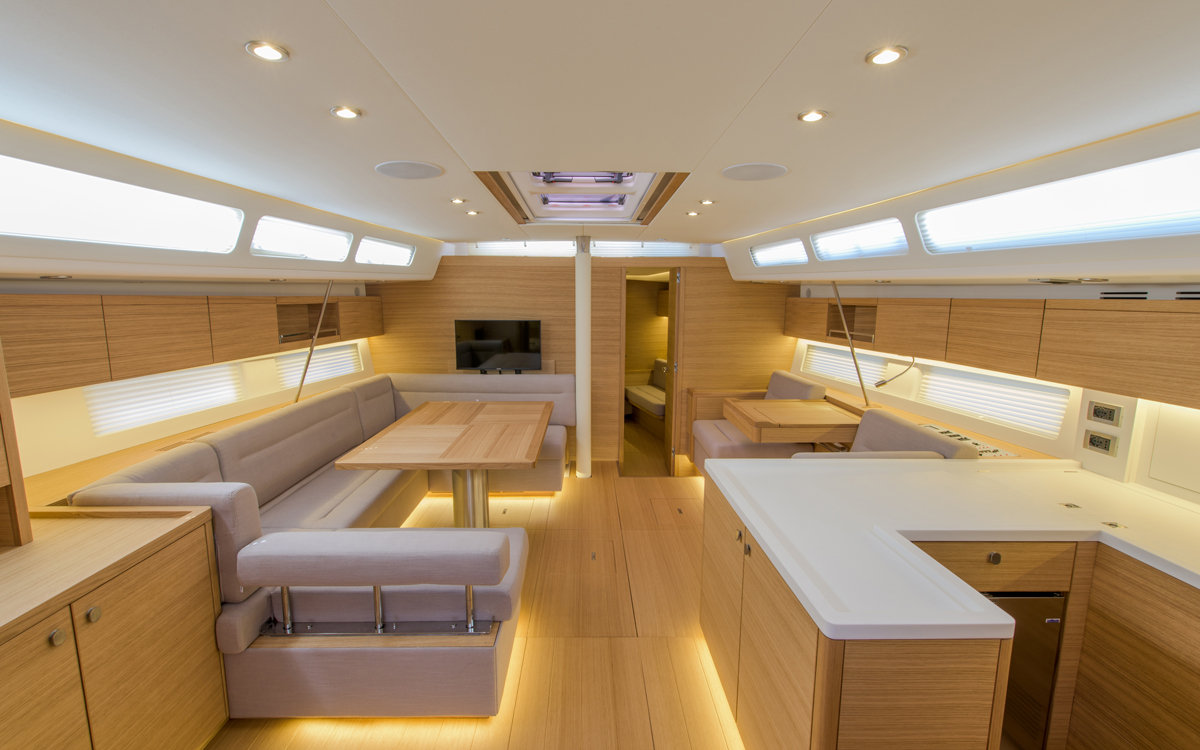
The interior focuses on space and light, with instruments and draining boards hidden behind locker doors
The tender garage is big enough to hold an inflated 2.7m tender. The transom drops down on hydraulic rams to create a bathing platform, which is accessed via a near vertical ladder. This steep drop may prove challenging for those with reduced mobility. Below decks the understated, stylish vibe continues. The layout is not remarkable but is ‘right’ – the emphasis is on space and light with a finish that is rich without being overly elaborate.
The test boat’s teak finish is to the same standard whether for the handrails or the inside of cupboard doors. Subtle, high quality details are everywhere, with brushed stainless steel, soft-close drawers, floor-level LED lighting and gas struts on every top-opening cupboard.
The living space is flooded by natural light from ample hatches and windows. The saloon is raised slightly, which helps create the space to house all the batteries and tankage beneath – nearly 600Ah of AGM house batteries and 600 litres of both fuel and water. There are various inspection hatches for servicing and access to tank valves as well as a glassfibre tray in the top of the keel that provides a very deep sump.
Most of the saloon is taken up with the U-shaped sofa and dining table, set over to the port side. Two individual seats flank a meagre chart table on the starboard side under which there can be stored another two folding chairs for the full dining set. As on deck, the navigation and boat management systems are hidden from view. Even the instruments are hidden behind a locker door.
Stepping down into the galley, the area is well planned and boasts 3m of wraparound worktops, two fridges, countless lockers and space for a freezer.
The draining area for washing-up is cleverly hidden in a locker over the sink, once again keeping the working aspects of life on board out of sight.
Accommodation
The 52LC can accommodate six guests in three cabins, plus has the option of converting the ample sail locker into crew accommodation. All cabins have plenty of natural light and ventilation using thoughtfully placed hatches and windows, which do not compromise on privacy. The standard layout for the aft cabins is a spacious twin and a double which, even under the cockpit sole, allows enough headroom to sit up on the bunks.
The wet hanging locker in the aft shower room was the only real provision I found for sailing in anything other than glorious weather. This space could house a washer dryer if chosen. All heads have elegant porcelain countertop bowl sinks and black water tanks are now fitted as standard.
I was a little surprised that the shower screen in the aft heads is a pull-out fabric blind, rather than the solid Perspex door used forward. The blind genuinely looked like it was on the wrong boat.

A smart look
and finish to the heads and shower areas – here, as elsewhere, utilities are neatly hidden
The owner’s suite is plush and roomy with a huge private heads and shower compartment. The standard layout has an island double bed against the forward bulkhead with the heads to port against the saloon bulkhead. For those who choose the crew cabin option, Grand Soleil suggests swapping the position of bed and heads to avoid the lack of privacy caused by adjoining bulkheads.
Our verdict
The Sport version of the 52LC sets out to hide the messy realism of sailing, while at the same time providing an efficient and stimulating experience for those who want to engage.
The boat feels well-built and was fun to helm, and while it will undoubtedly make quick miles in the right conditions, I get the impression sailing will be a secondary consideration to prospective owners. With the sailing controls confined to one area and an option of crew accommodation, Grand Soleil seems to be segregating those on board between crew and passengers, with the passengers’ comfort being paramount.
On a glorious sunny day, in flat water and with the right breeze, sailing the 52LC will be a joy. But for the majority of time, this boat will be enjoyed for its space, its looks, the admiration of others and the offering of a life less ordinary.
Specification
 LOA: 16.10m (52ft 10in)
LOA: 16.10m (52ft 10in)
LWL: 14.75m (48ft 5in)
Beam (Max): 4.85m (15ft 11in)
Draught: 2.6m (8ft 6in)
Displacement: 17,000kg (37,478lbs)
Ballast: 5,500kg (12,125lbs)
Sail area (100% foretriangle): 142.80m2 (1,537ft2)
Berths: 6-9
Engine: 56kW (75hp)
Water capacity: 600lt (132gal)
Fuel capacity: 600lt (132gal)
Price from (ex VAT): €617,000
Price as tested (ex sails): €745,350
Design: Marco Lostuzzi / Nauta Yachts
Builder: Cantiere del Pardo








